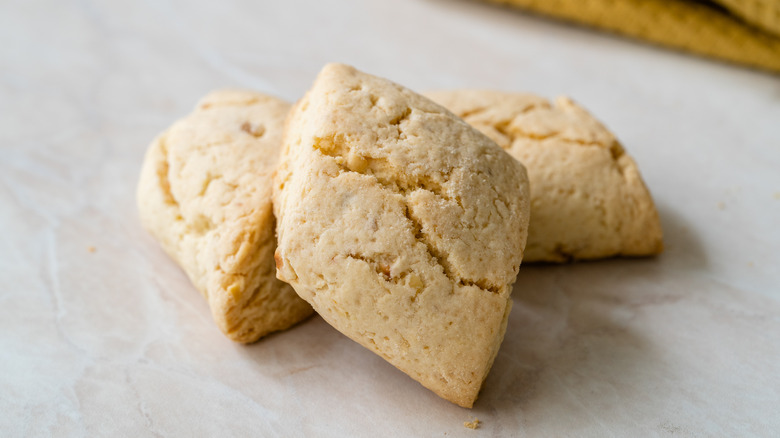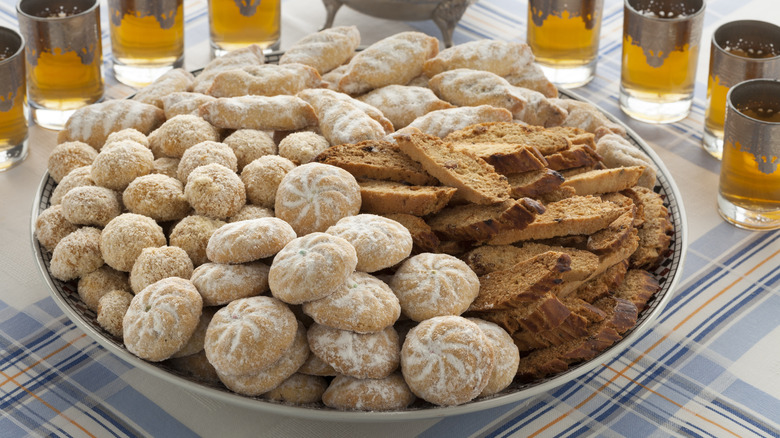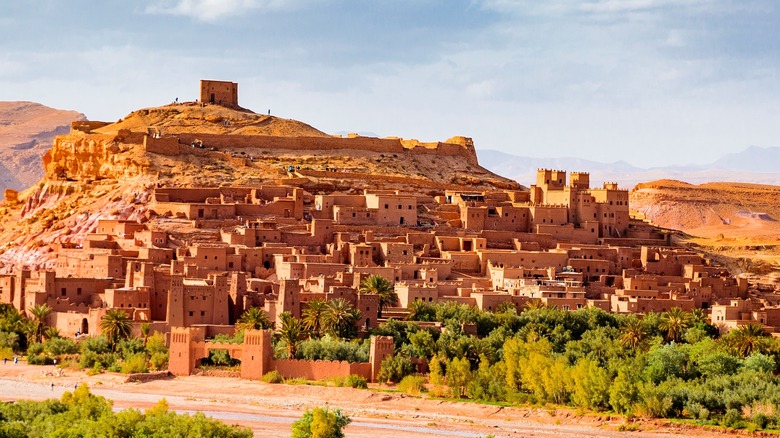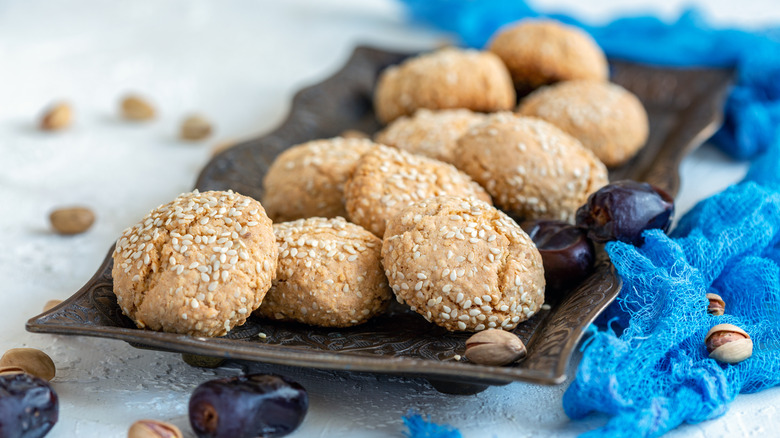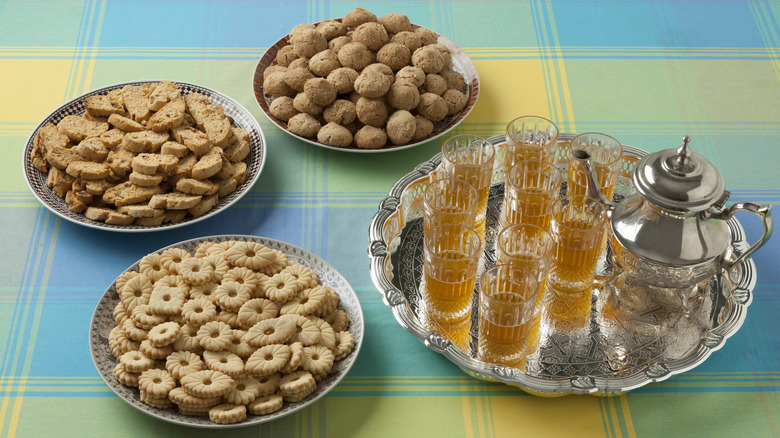The Classic Moroccan Shortbread Cookies With Distinct Crinkles
When it comes to well-known global food destinations, we believe Morocco is a little under-appreciated. This North African country showcases a varied and flavorful cuisine that has been formed from a number of external influences, from Arabs who introduced the country to essential spices to the pickling techniques of Jewish immigrants, as per Le Trou Au Mer.
Today, Morocco's diverse cuisine is full of bold, contradictory flavors and staple textures, whether it be tagine-cooked meat, fluffy couscous, or sweet mint tea. But, as Le Trou Au Mer explains, one of the most classic combinations Morocco is known for is sweet and crunchy foods, a category where many of the nation's one-of-a-kind desserts shine.
While Morocco does show off some tasty classics like baklava and lemon cake, their traditional shortbread cookies, ghoriba bahla, are a must-eat staple in the country. These simple cookies are likely nothing like any of the other shortbread you've tried before, due to their melt-in-your-mouth nature and "silly" crinkle qualities.
What are ghoribas
Moroccan Ghoribas, also spelled Ghriba or Ghriyba, are popular round-shaped cookies in Morocco that are made with different types of nuts, as per Cooking With Alia. There are many varieties of these types of cookies each made with slightly different ingredients. The main nuts can be anything from walnuts to almonds to coconut, and each type is flavored slightly differently as well, with a variety of spices and infusions from blossom water to cinnamon to honey.
Ghoriba bhala, though, is a crunchy and slightly crumbly shortbread cookie variety known for incorporating sesame seeds and almonds, per Taste of Maroc.
The translation of this cookie's name means "silly stranger," which comes from the fact these cookies develop cracks on their surfaces after being baked. It's likely this name caught on because the cracks make it look like the cookie is smiling at you (via The Spruce Eats).
This type of cookie gets the unique distinction of bhala only if it has the signature crinkle because bhala means "silly" or even "stupid," according to Taste of Maroc. While we will stick with the kinder version, we're certain either meaning will have you curious to try this one-of-a-kind shortbread.
A brief history of shortbread
While shortbread today may mainly be associated with Scotland, there's another shortbread origin story worth knowing, according to The Kitchn. It turns out, centuries ago, the first renditions of shortbread cookies in the Middle East were actually very similar to biscuits. According to the outlet, these confections were simply made of one part sugar, two parts fat, and three parts flour. These cookies, now known as ghoriba, have gone by different names depending on where they were being made, including ghorayebah in Egypt.
Eventually, these popular cookies spread across Spain as certain political powers shifted. Here, they were known as "polvo" meaning dust. The great ghoriba migration continued making it to the Americas where they are still popular today, especially in South America and Mexico.
While Scottish shortbread developed separately from this Moroccan lineage, they are still worth comparing. They arose at similar times, as Daring Gourmet mentions that Scottish shortbread also came about around the 12th century, and they also started out as similar to biscuits. Their traditional ingredient list also matches up, as The View From Great Island mentions that Scottish shortbread was only made with sugar, butter, and flour.
However, it seems ghoriba has always been a bit more festive, often including added flavors like rosewater, almonds, and pistachios, while the Scottish counterpart opted for a more plain take. And, ghoriba bhalas in particular tend to take on a nuttier flavor.
Ingredients in ghoriba bahla
Ghoriba bahla's ingredients are similar to other shortbread cookies, and the ingredients list is kept short and simple. The dry ingredient list includes sugar, along with vanilla sugar for added flavoring, all-purpose flour, baking powder, and a pinch of salt, as per The Spruce Eats. Unsalted butter and vegetable oil are added to make a dough that's on the drier side, perfect for achieving that classic crumbly and sandy shortbread texture. Although, it shouldn't be so dry that it won't shape into a cookie, as Taste of Maroc points out.
These cookies would not be complete without sesame seeds (optionally toasted) and almonds. Some simply add the sesame seeds to the dough while others roll the cookie in them. As for the almonds, one of the distinguishing qualities of this cookie is that almonds almost act as a flour, as they are blanched, fried, then ground.
While these cookies can be eaten plain, these two nutty flavor infusers have become iconic. Taste of Maroc notes that you can add pecans for an extra earthy kick, but it is not part of the traditional recipe.
How ghoriba bahla is made and eaten
The first step in making ghoriba bahla is to form a dough out of both the dry and wet ingredients, according to Cooking with Alia. Small pieces of the dough can be broken off to form the cookies, which are rolled between the baker's palms and gently flattened into a rounded disc-like shape, and then they're baked. The color changes very little, retaining its light golden coloring and gaining the slight cracks in the edges that it needs to fulfill its namesake.
Traditionally, as The Spruce Eats notes, these cookies were originally molded using a special baking sheet. The sheets were designed with rounded bottoms, allowing the cookies to bake into a fuller shape. However, today, most bakers use a typical, flat cookie sheet while making these cookies.
Unlike those gooey chocolate chip cookies that are best eaten fresh out of the oven, Cooking With Alia suggests to let the cookies cool down before eating them. Otherwise, an undesirable crumbling will occur. While they are crumbly cookies by nature, you don't want them to fall apart in your hand while eating them.
Once cooled, they're best served with a hot beverage. Coffee or traditional Moroccan mint tea are both great options. Taste of Maroc adds that these cookies are also great when paired with other Moroccan ghoribas, creating an ideal dessert platter.
